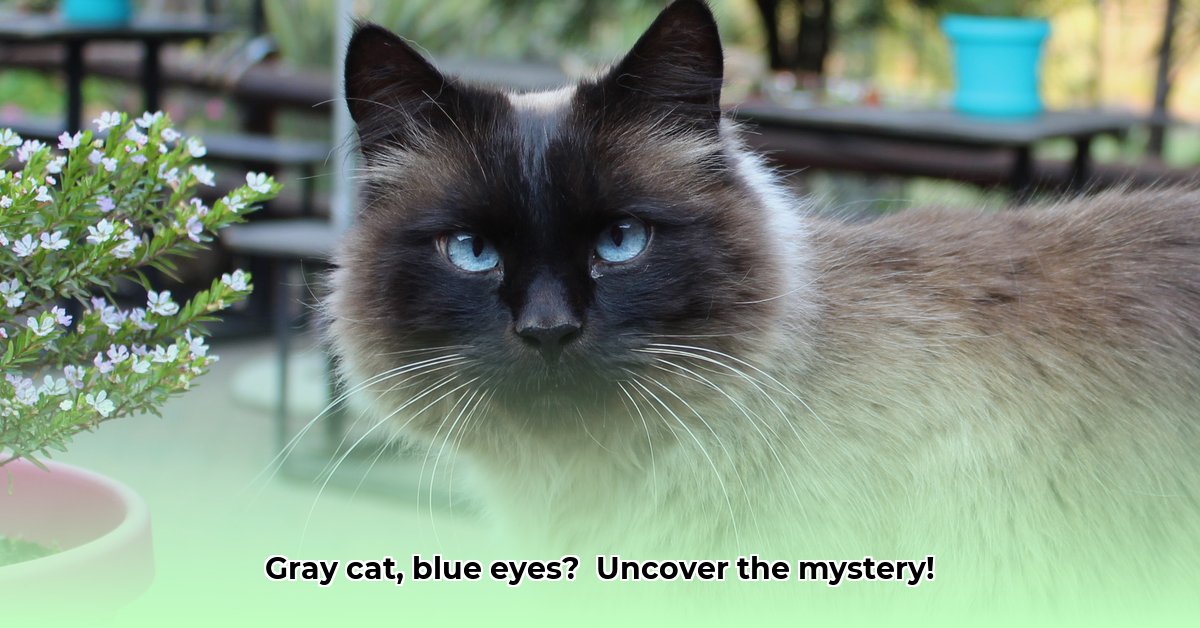Have you ever been mesmerized by a gray cat sporting striking blue eyes? It’s more than just a captivating combination of colors; it’s an intriguing mix of genetics and specific breed characteristics. For more on long-haired varieties, check out this guide on long-haired gray cats. This in-depth guide explores the breeds known for this captivating look, explains the science behind their unique coloring, and provides essential tips for potential owners to ensure a long, healthy, and joyful life for these feline companions. Whether you’re a seasoned cat enthusiast or considering cat ownership for the very first time, prepare to delve into the enchanting realm of gray cats with blue eyes.
The Allure of Gray Cats with Blue Eyes: A Comprehensive Exploration
The appeal of a gray cat with piercing blue eyes is truly undeniable, representing a blend of elegance and a certain mystique that captivates the hearts of many. However, this visually stunning combination goes beyond mere aesthetics. A thorough understanding of the underlying genetics and breed predispositions is of paramount importance for ensuring the overall health and well-being of these unique felines. Let’s embark on a journey into the captivating world of these remarkable cats.
Decoding the Mystery of Gray and Blue: Understanding Feline Genetics in Depth
The captivating blue eyes and distinctly gray coat observed in certain cat breeds are not simply a matter of chance; they are deeply rooted in the fascinating science of genetics. The gray coat color typically arises from the presence of a “dilution gene,” which essentially softens the intensity of the natural coat color. In contrast, the mesmerizing blue eyes result from a separate set of genes that influence the production and distribution of pigment within the iris. It’s the intricate interplay between these distinct genetic factors that gives rise to this highly sought-after combination of traits. While research into feline genetics is constantly evolving, the fundamental principles already offer valuable insights into how this complex relationship manifests in these unique cats.
Breeds that Exemplify the Gray and Blue Aesthetic: Exploring Specific Breed Characteristics
Several recognized cat breeds are particularly renowned for their distinctive gray coats and captivating blue eyes. It’s important to note that while these breeds are known for this combination, it’s not always guaranteed, as each cat is a unique individual and can exhibit variations in appearance. The following are some of the most commonly encountered breeds associated with this striking combination:
- Siamese: Typically known for their pointed coats (lighter body with darker extremities), some Siamese cats can exhibit a diluted gray or blue-point coat, which beautifully complements their signature blue eyes.
- Russian Blue: These elegant and refined cats are highly regarded for their shimmering silver-gray fur, which possesses a unique plush texture, and their strikingly bright blue-green eyes.
- Korat: Easily distinguished by their shimmering silver-tipped blue coat, often described as “rain-cloud gray,” and their captivatingly large and luminous blue-green eyes, Korats are a true sight to behold.
- British Shorthair: While not exclusively blue-eyed, certain British Shorthairs can possess a lovely gray, or “blue,” coat paired with intense copper or golden blue eyes, which significantly enhances their overall charm.
- Ragdoll: Some Ragdoll cats exhibit colorpoint patterns that result in gray or “blue” shading, particularly in the points (ears, face, tail, and paws), which beautifully contrasts with and accentuates their magnificent blue eyes.
- Snowshoe: A captivating breed resulting from the crossbreeding of Siamese and American Shorthair cats, Snowshoes inherit the striking blue eyes of the Siamese, often paired with a unique colorpoint pattern that can include a beautiful grey or blue hue on their points.
Embarking on the Journey to Find Your Perfect Gray Companion: Adoption vs. Breeders – Weighing Your Options
Bringing a gray cat with blue eyes into your life represents a significant decision that should be approached with careful consideration and planning. Generally, there are two primary avenues for acquiring such a feline companion: adoption and purchasing from a reputable breeder.
Option 1: Adoption – Providing a Loving Home to a Cat in Need
Numerous animal shelters and rescue organizations often have gray cats with blue eyes awaiting loving homes. Opting for adoption offers the dual benefit of providing a deserving cat with a second chance at a fulfilling life while also creating a loving and enriching companionship for yourself.
Option 2: Reputable Breeder – Ensuring Responsible Breeding Practices
If you have a strong preference for a specific breed known for its gray coat and blue eyes, seeking out a responsible and ethical breeder is essential. A reputable breeder will prioritize the health, genetic soundness, and overall well-being of their cats, conduct comprehensive health screenings to minimize the risk of hereditary diseases, and maintain complete transparency regarding their breeding practices. It’s crucial to exercise caution and avoid breeders who appear more concerned with profit than the welfare of their cats.
Navigating the Search: Red Flags to Watch Out For When Choosing a Breeder:
- Evasiveness and Unwillingness to Answer Questions: A reputable breeder should be open and willing to answer all your questions thoroughly and honestly.
- Lack of Health Testing and Genetic Screening: Breeders who fail to conduct health tests or genetic screenings on their cats may be contributing to the propagation of hereditary health issues.
- Pressure to Buy Quickly and High-Pressure Sales Tactics: Responsible breeders will allow you ample time to consider your decision and will never pressure you into making a hasty purchase.
- Unclean or Unsanitary Living Conditions: The environment in which the cats are raised should be clean, spacious, and well-maintained to ensure their health and well-being.
Navigating Potential Health Considerations: Being Aware of Breed-Specific Challenges
Certain breeds associated with gray coats and blue eyes may be predisposed to a higher risk of specific health concerns. It’s important to emphasize that this does not guarantee that every cat of these breeds will develop these issues, but it is something to be aware of and prepared for. Potential health concerns may include:
| Potential Health Concern | Detailed Description |
|---|---|
| Hearing Impairment | Some cats with blue eyes, particularly those with white fur, may have a higher likelihood of experiencing some degree of hearing loss, ranging from mild to complete deafness, in one or both ears. This is due to a genetic link between the genes that control coat color and those that affect the development of the inner ear. |
| Eye Conditions | While not always a direct consequence of blue eyes, some cats may exhibit increased sensitivity to bright light or be prone to certain eye conditions, such as progressive retinal atrophy (PRA) or glaucoma. Regular veterinary check-ups, including ophthalmological examinations, can help detect and manage these potential issues early on. |
| Breed-Specific Genetic Conditions | Each cat breed is predisposed to its own set of unique genetic health problems. For instance, Russian Blues may be prone to certain metabolic disorders, while British Shorthairs may be at a higher risk of developing hypertrophic cardiomyopathy (HCM), a heart condition. Consulting with your veterinarian and reputable breeder (if applicable) is crucial for understanding the specific health risks associated with your chosen breed and implementing preventative measures. |
| White Spotting | The presence of white spotting, often associated with blue eyes, can sometimes be linked to an increased risk of certain health issues, such as neural tube defects or congenital deafness. While not all cats with white spotting will experience these problems, it’s important to be aware of the potential risks and work with your veterinarian to monitor your cat’s health closely. |
Regular veterinary check-ups are of paramount importance for early detection, diagnosis, and effective management of any potential health issues that may arise. Openly discuss any concerns you may have with your veterinarian and breeder (if applicable) to develop a comprehensive plan for your cat’s long-term health and well-being. According to Dr. Emily Carter, DVM at the Animal Medical Center, “Early detection is absolutely key to successfully managing any potential health issues that may arise in these unique breeds. Regular checkups and a proactive approach to veterinary care can make a significant difference in a cat’s quality of life.”
Owner’s Guide: Providing a Foundation for a Happy and Fulfilling Life Together
Once you’ve welcomed your gray cat with blue eyes into your home, it’s essential to provide them with the appropriate care and attention they require to thrive. Here’s a comprehensive guide on how to ensure your new companion enjoys a happy, healthy, and fulfilling life:
- Nutrition: Feed your cat a high-quality, nutritionally balanced diet that is specifically formulated for their age, activity level, and any specific health needs they may have. Consult with your veterinarian to determine the best food choices for your cat.
- Grooming: Establish a regular grooming routine to help maintain a shiny, healthy coat and minimize shedding. The frequency and
















